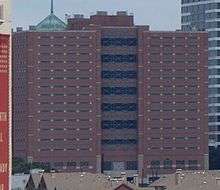Tarrant County Corrections Center

The Tarrant County Corrections Center (TCCC) is a detention center located in Downtown Fort Worth in Tarrant County, Texas. Designed to house prisoners either awaiting trial, transfer or serving short jail sentences, the structure handles both male and female inmates. The jail was constructed in 1990 after several delays and became best known in 2000 when a religious education program run by its chaplain was challenged and declared unconstitutional. At 203 feet (62 m) in height, the center is one of the tallest buildings in Fort Worth and the largest prison structure in the city.
History
The Tarrant County Corrections Center was constructed in 1990 because of overcrowding in nearby prisons. Completion of the prison was reportedly delayed by several causes, mainly issues with budgeting.[1] Upon completion, the building was the first fully functional direct-supervision jail in Texas. Over 1,440 maximum-security prisoners were transferred from nearby facilities once the Corrections Center was opened, including female inmates. During its first few years, the facility was one of the best in the state; its warden reported that it had "not had one piece of graffiti written on the walls, one toilet stopped up, [or] one inmate struck or injured".[2][3] A total of fifty dollars of a twenty-thousand dollar budget was spent during the first year of operation, used for replacing two broken windows.[3] The center's first incident occurred in 2005, when an inmate attacked two guards with an improvised shiv.[4] The facility began suffering from overcrowding around 2010, so Fort Worth constructed a new jail, the Lon Evans Corrections Center, to handle more dangerous prisoners.[5][6]
Chaplain's Education Unit
The Chaplain's Education Unit (CEU) was a religious educational program operated by the facility beginning in 1992. Originally a men's program, a women's branch was opened in 1993. The program, informally referred to as the "God Pod", was organized by the county sheriff and prison chaplain and run by a team of volunteers. It was designed to educate prisoners in Christian belief, based on the ideals believed by the sheriff and chaplain, which were meant to be "orthodox Christian principles". The program included up to 48 prisoners at a time, who were housed in a specialized area of the facility for a 120-day period.[7][8] In 2000, two former prisoners and a local resident sued the Corrections Center, arguing that the program was a violation of religious freedom, since it allowed only for teaching of Christian principles. In 2001, the program was found to be unconstitutional, and was shut down.[9]
Facilities
Designed by the Dallas-based HOK Architects, the Corrections Center is 203 feet (62 m) tall and has seventeen floors, making it one of only twenty-one structures in Fort Worth greater than 200 feet (61 m) tall. The building is designed in a postmodernist style, using buff-colored bricks, with cast stone as trimming. There are four jail pods located on each corner of the structure, with an outdoor recreational facility located between the east and west parts.[10][11] The center is located on Lamar Street, in an area near the center of Downtown Fort Worth, a location which has drawn criticism from some residents.[5][6] The center is connected to the Lon Evans center by a skyway on the fourth floor and an underground tunnel.[5][12]
See also
References
- ↑ Tarrant County Sheriff's Office, ed. (2004). Tarrant County Sheriff's Office: Over 150 Years of Service. Nashville, TN: Turner Publishing Company. p. 15. ISBN 1-5631-1942-0. OCLC 61757786.
- ↑ Hadden, Britton; Luce, Henry Robinson (1992). "Jailhouse Gym With A Downtown View". Time. New York City. 139 (19): 53–54. ISSN 0040-781X. OCLC 1311479.
- 1 2 Runkel, Philip J. (2003). "Degrees of Freedom II". People as Living Things: The Psychology of Perceptual Control. Hayward, CA: Living Control Systems Publishing. p. 398. ISBN 978-0-9740155-0-7.
- ↑ Livingston, Terrie (2005). "Clifford Aurich v. The State of Texas--Appeal from 371st District Court of Tarrant County". US Law. Justia.com. Texas Court of Appeals, Second District Decisions. Retrieved February 4, 2014.
- 1 2 3 Staff writer (September 19, 2012). "Tarrant County jail officials show off new home for 'worst of the worst'". Fort Worth Star Telegram. Fort Worth, TX. p. 23. ISSN 0889-0013. OCLC 699332130.
- 1 2 Staff writer (May 9, 2010). "Tarrant County to begin work on new jail in downtown Fort Worth". The Dallas Morning News. Dallas. Fort Worth. ISSN 1553-846X. OCLC 44336180. Retrieved February 4, 2015.
- ↑ American Jewish Congress (January 27, 2001). "'God Pod Case' to be Heard By Texas Supreme Court Will Represent Key Appellate Level Challenge to Charitable Choice Programs, AJCongress Says" (Press release). PR Newswire. Retrieved February 5, 2015.
- ↑ Hankinson, Deborah G. (June 21, 2001). "In The Supreme Court of Texas" (PDF). Court of Appeals for the Second District of Texas. The New York Times. pp. 1–5. Retrieved February 5, 2015.
- ↑ Roberts, Scott (Fall 2002). "The Constitutionality Of Prison-Sponsored Religious Therapeutic Communities". Regent University Law Review. Virginia Beach, VA. 15 (69): 88–89. OCLC 61312428.
- ↑ Staff. "Tarrant County Corrections Center". Tallest buildings in Fort Worth. Emporis.com. Retrieved February 4, 2015.
- ↑ Roberts, John (2014). "Tarrant County Corrections Center". Downtown Fort Worth. Architecture in Fort Worth. Retrieved February 4, 2015.
- ↑ Staff (2012). "Tarrant County Jail–Fort Worth, Texas" (PDF). David M. Schwarz, Architects. Retrieved February 4, 2015.
External links
Coordinates: 32°45′21″N 97°20′12″W / 32.7558°N 97.3367°W